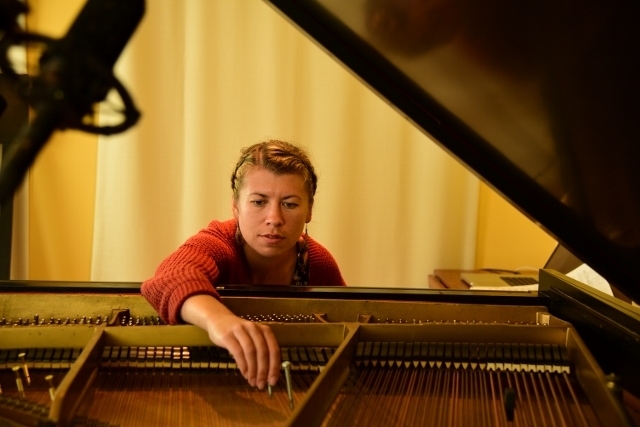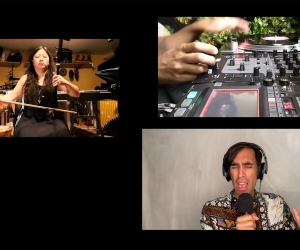
With its balance of bold colour palettes, strong melodic profiles, and unexpected performative elements, composer Anna Pidgorna’s work has been catching eyes and ears of late. Her chamber opera On the Eve of Ivan Kupalo recieved a 2013 SOCAN Foundation Award, and Light-Play through Curtain Holes, a solo accordion piece, represented Canada at the ISCM World New Music Days 2013 in Vienna. She’s worked with leading contemporary music performers such as the Gryphon Trio, Rachel Mercer, New Music Concerts, Janice Jackson, the Thin Edge New Music Collective, and Katelyn Clark. She’s currently at Princeton completing a PhD.
Over the past several years, Pidgorna’s Ukrainian heritage has become increasingly important to her work through the integration and quotation of folk musics. In 2012 she received a Canada Council grant to visit Ukraine to study with and record practitioners of folk idioms. In her writing for instruments, she has for some time used the ornamentation and timbral nuances that characterize such music, and she has more recently been generating a repertoire of folk-song-inspired work for her own singing with different ensembles. Musicworks contributing editor Nick Storring spoke to Pidgorna about this unique hybrid work. This interview has been condensed and edited.
MUSICWORKS: Tell me more about your creative journey with Ukrainian folk idioms.
ANNA PIDGORNA: Initially, I was looking at transcriptions of songs, but then I actually heard villagers singing them as part of a Soviet-era cartoon. The sound was different than what was on the page, so I started hunting around for recordings.
When I started transcribing them myself, I realized how much tuning is part of it. What was logically a major third, for example, and even fifths, octaves, and unisons, sounded much more dissonant. Eventually I realized this had to do with the timbre of the voice. The small expressive ornamental gestures get left out in many transcriptions as well.
I secured contacts with Ukrainian ethnomusicologists that helped me visit and hear this stuff in its natural habitat. I often sat around a dining table and all the women would just start singing. I got a much clearer idea of how the counterpoint and the harmonies worked. I could actually look right into their mouths as they sang. Something about the way you’re formulating the sound when you’re singing makes it very natural to produce the ornaments. When you’re belting it out, as opposed to singing in a classical way, your voice will sort of squeak up to higher partials or fifths. I think that’s an important part of the tradition.
MW: What is your background in singing?
AP: I sang in choir in undergrad and recently I’ve been taking classical voice lessons through Princeton. That’s helped to improve breath control and things like that.
While I was attending lectures at an academy in Ukraine, I participated in some rehearsals of their student folk ensemble. It was the beginning of the semester, so they were just getting into the timbre and ornaments. Since then I’ve been working a lot from recordings. I sing a lot when I go on walks in nature, belting this stuff out. I follow the familiar pathways that these melodies take, but I work o on my phone or Zoom recorder.
MW: Tell me more about these invented folk pieces that you’ve been creating.
AP: The first one, Weeping for a Dead Love (for voice and percussion quartet), works from the weeping-song tradition—a half-chanted, half-sung genre women perform at funerals. Lyrically there’s a formula that gets filled with information pertaining to the deceased. As it’s sung, the singer’s emotions come through more—their voices break, they start crying. It becomes a release. In my piece, I looked at it as mourning a dead relationship rather than a person—I had recently gone through a traumatic breakup. Folk music often expresses heartbreak, but in formats that everyone can connect with.
Currently, I’m in the early stages of working on something for myself and the violin and piano duo aTonalHits. The piece employs a folk song that I recorded during my visit. It stuck with me because it’s so violent, but strangely upbeat. Eventually, I realized my memory of it was absolutely different. I use this remembered version to weave through the original song my response to the rape and murder by immolation of Ukrainian teenager Oksana Makar.
When the Makar case was on the news I felt compelled to find a way to mourn her and bring it to the public’s attention. After some research, it seems there’s actually a whole subgenre of songs in Eastern Europe about abducting and burning young women. This particular one turns out to be rather popular. My parents know it—it’s used as a marching song for soldiers (soldiers assault the girl in the song!) and women also sing it at weddings. The song shows a similar reaction to Oksana’s death: after people were done being horrified they assigned fault with her.
In general, I saw a lot of sadness when I visited, too—a lot of stories of really extreme physical and sexual abuse. Domestic violence is so prevalent that there are countless folk tunes about it. It’s been important for me to try to process those negative emotions.
MW: How do you deal with balance notation and improvisation in such pieces?
AP: I haven’t made a decision on this newer piece. With Weeping for a Dead Love I recorded myself singing it, and then very roughly transcribed it just so the percussion quartet had something to follow loosely. The piece wasn’t metred or anything. It gave me a lot of freedom, but it did restrict the complexity of the percussion writing to some extent.
I’ll be taking this new trio—probably only a sketch—to a residency at Avaloch Farm in New Hampshire, and the ensemble and I will see how much needs to be notated and how much can exist in a more folk-like realm. I envision having an opportunity to improvise vocally in the piece, over an instrumental background—either completely written-out or also improvised. I was initially planning to prepare the piano, but I am also enjoying the contrast of clean piano with the folk-inspired soundworld. In the violin part, I’m going to include more timbral variation and folk-like ornamentation.
FYI: Anna Pidgorna's new work for accordion and saenghwang (a traditional Korean instrument) will premiere in Squeezebox , a concert presented by Soundstreams, in Toronto on Feb. 10, 2016.
Audio: Weeping for a Dead Love (2015). Composed by Anna Pidgorna. Performed by Anna Pidgorna (voice) and So Percusion (Eric Cha-Beach, Josh Quillen, Adam Sliwinski, and Jason Treuting). Photo of Anna Pidgorna by Illya Filshtinskiy.

